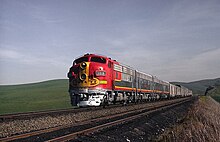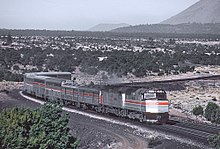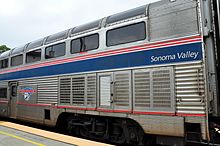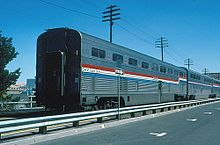Hi-Level
The Hi-Level was a type of bilevel intercity railroad passenger car used in the United States.
Vestibules on the upper level permitted passengers to walk between cars; some coaches had an additional stairwell at one end to allow access to single-level equipment.
The train ran on the Santa Fe's main line between Chicago and Los Angeles.
Passengers flocked to the new train, and the Santa Fe added cars to meet the demand.
Two popular innovations by the Chicago, Burlington and Quincy Railroad (CB&Q) suggested a solution.
First, in 1945, the CB&Q introduced the dome car, in which passengers rode on a second level high above the tracks, affording better views.
Taken together, these innovations suggested a new possibility: a long-distance bilevel coach, with greater capacity than single-level cars, and the panoramic views of a dome.
These constituted five equipment sets ("consists"), sufficient for daily service on the El Capitan.
[8] A press trip took place between Washington, D.C., and Pittsburgh on June 16, 1956, using the route of the Baltimore and Ohio Railroad (and presaging the use of Superliners on Amtrak's Capitol Limited).
A formal christening took place in Albuquerque, New Mexico, on July 8, with the duke of Alburquerque in attendance.
As Fred Frailey explained:[11] ... a conventional El Cap ran 16 cars, carried 438 people and weighed 1,069 tons.
Fred Gurley's $13 million got Santa Fe a 13-car train (including the same head-end cars) that carried 130 additional people and weighed 110 tons less ...Trains editor David P. Morgan thought the equipment was "comfortable" and "[rode] well, even above 90 mph".
The Hi-Level cars continued in service after the Santa Fe combined the El Capitan and Super Chief in 1958.
Visually they resembled the CNW's existing commuter equipment; a noticeable difference from the Hi-Levels was the adoption of head-end power (HEP) instead of steam.
Unlike the El Capitan, the Chief carried a mix of sleeping cars and coaches.
[7] This was the final major order for new long-distance passenger equipment before the coming of Amtrak; after Kansas City Southern Railway bought ten new coaches from Pullman-Standard in 1965, no new locomotive-hauled coaching stock would be built until the first Amfleets arrived a decade later.
In 1971 the United States federal government created Amtrak, a subsidized for-profit corporation, to take over intercity services and reverse the decline.
[27] Amtrak was impressed with the Hi-Levels and used them as the basis for the design of the bilevel Superliner family of railcars.
[28] As the Superliners went into service, Hi-Levels could be found on more of Amtrak's trains throughout the Western United States.
[31] Dining cars displaced from the Southwest Limited filled in on the Ogden, Utah–Los Angeles Desert Wind.
[37] The private equity fund Corridor Capital owns most of the fleet, and has proposed employing them for various passenger projects within the United States, including a plan to revive the Coast Daylight.
[42] The railway writer and historian Karl Zimmermann called them "the greatest treat for sleeping car passengers on Amtrak".
[44] Amtrak retired the cars after their last run on February 4, 2018, citing safety concerns and rising maintenance costs.
Budd and the Santa Fe expected the upper level, located 8 feet 7 inches (2.62 m) above the rails, to provide a smoother, quieter ride for passengers.
With the lower level free of passengers, designers could provide larger restrooms and baggage areas.
Finally, the lower level contained all the electrical equipment, away from the passengers, and with easy access for maintenance.
[1] Budd built the Hi-Levels with steam heating, the standard method for ensuring passenger comfort in the 1950s.
For air conditioning and other electrical needs, it chose to employ independent diesel generators in each car.
The lower level housed the kitchen, including ovens, hot plates, a refrigerator, and a dishwasher.






